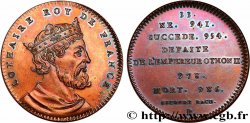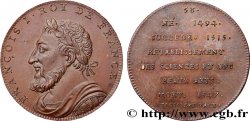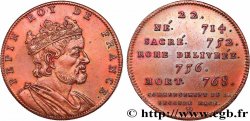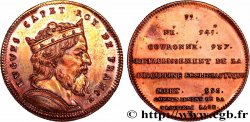fjt_743120 - SÉRIE MÉTALLIQUE DES ROIS DE FRANCE Règne de PHILIPPE I - 38 - Émission de Louis XVIII n.d.
35.00 €
Quantità
Aggiungi al carrello

Tipo : Règne de PHILIPPE I - 38 - Émission de Louis XVIII
Data: n.d.
Metallo : ottone
Diametro : 32 mm
Asse di coniazione : 12 h.
Peso : 12,77 g.
Orlo : cannelée
Grado di rarità : R1
Pedigree :
Exemplaire provenant de la Collection MARINECHE
Diritto
Titolatura diritto : PHILIPPE I ROY DE FRANCE.
Descrittivo diritto : Buste imaginaire couronné et drapé à gauche.
Rovescio
Titolatura rovescio : 38 - NÉ 1052* - SUCCEDE 1060 - PUBLICATION DE LA CROISADE 1095 - MORT 1108 - TROISIEME RACE / P..
Descrittivo rovescio : en huit lignes.
Commento
Philippe Ier de France, né en 1052, mort le 30 juillet 1108 au château de Melun en Seine-et-Marne, fut roi des Francs de 1060 à 1108, quatrième de la dynastie dite des Capétiens directs.
Il est le fils d'Henri Ier, roi de France, et d'Anne de Kiev
Philippe est sans doute le premier prince en Europe occidentale à recevoir ce prénom qui allait se perpétuer jusqu'à nos jours. Il le doit à sa mère, Anne de Kiev, dont l'arrière grand-père paternel Romain II, empereur de Constantinople, affirmait descendre des rois de Macédoine.
Couronné à Reims le 23 mai 1059 du vivant de son père, Philippe Ier ne règne seul qu’à partir de 1066, car son oncle, le comte de Flandre Baudouin V, assisté de l’archevêque de Reims Gervais de Belleme ainsi que, dans un premier temps, d'Anne de Kiev, exerce la régence de la mort d'Henri Ier en 1060 à 1066. Il sera couronné plusieurs fois dans son règne, par exemple le 25 décembre 1071, par l'évêque Élinand, en la cathédrale Notre-Dame de Laon comme le voulait la coutume de son temps.
Pour la suite de la biographie, voir http://fr.wikipedia.org/wiki/Philippe_Ier_de_France.
Philip I of France, born in 1052 and died on July 30, 1108, at the Château de Melun in Seine-et-Marne, was King of the Franks from 1060 to 1108, the fourth of the dynasty known as the direct Capetians. He was the son of Henry I, King of France, and Anne of kyiv. Philip is probably the first prince in Western Europe to receive this first name, which would continue to this day. He owes it to his mother, Anne of kyiv, whose paternal great-grandfather, Romanus II, Emperor of Constantinople, claimed descent from the kings of Macedonia. Crowned in Reims on 23 May 1059 during his father's lifetime, Philip I only reigned alone from 1066, because his uncle, the Count of Flanders Baldwin V, assisted by the Archbishop of Reims Gervais de Belleme and, initially, by Anne of kyiv, exercised the regency from the death of Henry I in 1060 to 1066. He was crowned several times during his reign, for example on 25 December 1071, by Bishop Élinand, in the Notre-Dame Cathedral of Laon as was the custom of his time. For the rest of the biography, see http://fr.wikipedia.org/wiki/Philippe_Ier_de_France
Il est le fils d'Henri Ier, roi de France, et d'Anne de Kiev
Philippe est sans doute le premier prince en Europe occidentale à recevoir ce prénom qui allait se perpétuer jusqu'à nos jours. Il le doit à sa mère, Anne de Kiev, dont l'arrière grand-père paternel Romain II, empereur de Constantinople, affirmait descendre des rois de Macédoine.
Couronné à Reims le 23 mai 1059 du vivant de son père, Philippe Ier ne règne seul qu’à partir de 1066, car son oncle, le comte de Flandre Baudouin V, assisté de l’archevêque de Reims Gervais de Belleme ainsi que, dans un premier temps, d'Anne de Kiev, exerce la régence de la mort d'Henri Ier en 1060 à 1066. Il sera couronné plusieurs fois dans son règne, par exemple le 25 décembre 1071, par l'évêque Élinand, en la cathédrale Notre-Dame de Laon comme le voulait la coutume de son temps.
Pour la suite de la biographie, voir http://fr.wikipedia.org/wiki/Philippe_Ier_de_France.
Philip I of France, born in 1052 and died on July 30, 1108, at the Château de Melun in Seine-et-Marne, was King of the Franks from 1060 to 1108, the fourth of the dynasty known as the direct Capetians. He was the son of Henry I, King of France, and Anne of kyiv. Philip is probably the first prince in Western Europe to receive this first name, which would continue to this day. He owes it to his mother, Anne of kyiv, whose paternal great-grandfather, Romanus II, Emperor of Constantinople, claimed descent from the kings of Macedonia. Crowned in Reims on 23 May 1059 during his father's lifetime, Philip I only reigned alone from 1066, because his uncle, the Count of Flanders Baldwin V, assisted by the Archbishop of Reims Gervais de Belleme and, initially, by Anne of kyiv, exercised the regency from the death of Henry I in 1060 to 1066. He was crowned several times during his reign, for example on 25 December 1071, by Bishop Élinand, in the Notre-Dame Cathedral of Laon as was the custom of his time. For the rest of the biography, see http://fr.wikipedia.org/wiki/Philippe_Ier_de_France








 Segnalare un errore
Segnalare un errore Stampate la pagina
Stampate la pagina Condividi mia selezione
Condividi mia selezione Fai una domanda
Fai una domanda Consegnare / vendere
Consegnare / vendere
 Descrittivo
Descrittivo









